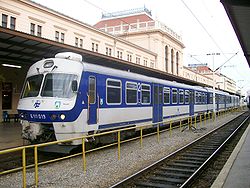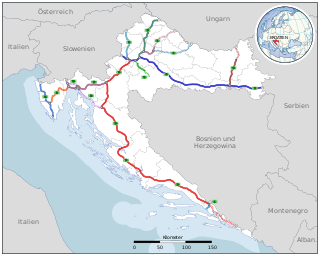
Transport in Croatia relies on several main modes, including transport by car, train, ship and plane. Road transport incorporates a comprehensive network of state, county and local routes augmented by a network of highways for long-distance travelling. Water transport can be divided into sea, based on the ports of Rijeka, Ploče, Split and Zadar, and river transport, based on Sava, Danube and, to a lesser extent, Drava. Croatia has 9 international airports and several airlines, of which the most notable are Croatia Airlines and Trade Air. Rail network is fairly developed but regarding inter-city transport, bus tends to be far more common than the rail.

The Mumbai Suburban Railway consists of exclusive inner suburban railway lines augmented by commuter rail on main lines serving outlying suburbs to serve the Mumbai Metropolitan Region. Spread over 390 kilometres (240 mi), the suburban railway operates 2,342 train services and carries more than 7.5 million commuters daily.
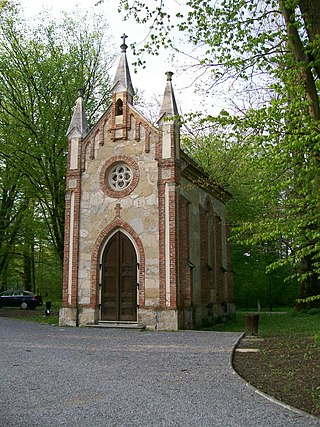
Zaprešić is a town in Hrvatsko zagorje, Zagreb County in Croatia. It has a population of 19,644 inhabitants in the town proper, with 25,223 in the administrative area. The town's metropolitan area, which encompasses the seven neighbouring municipalities, has a population of 54,640. Zaprešić is the third-largest, and most densely populated town of the county. It is located northwest of the Croatian capital Zagreb, and near the Slovenian border. It is centered on plains north of the Sava River, and is bordered by Medvednica Mountain to the east, and the Marija Gorica Hills to the west.
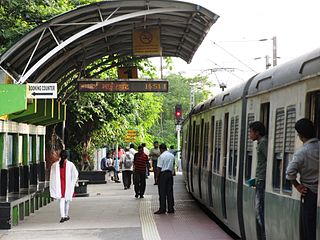
The Kolkata Suburban Railway is a suburban rail system serving the Kolkata metropolitan area and its surroundings in India. It is the largest suburban railway network in the country by number of stations and track length, and also one of the largest in the world. There are five main lines and nineteen branch lines. It operates more than 1,500 services, carrying 3.5 million people daily and 1.2 billion people every year. It runs from 03:00 am until 02:00 am and fares range from Rs.5 to Rs.25. The system uses 25 kV 50 Hz AC power supply and runs on 5 ft 6 in broad gauge track. It has interchange stations with the Kolkata Metro at various locations.

Croatian Railways is the national railway company of Croatia. Croatia is a member of the International Union of Railways (UIC). The UIC Country Code for Croatia is 78. The Croatian rail network carried 20.270 million passengers in 2018.

Dugo Selo is a town in Zagreb County, Croatia.
This is a list of past and present rolling stock owned and operated by Croatian Railways, consisting of diesel locomotives, electric locomotives, diesel multiple units, electric multiple units and railroad cars. When the company began operation in 1991, it was with a collection of equipment inherited from „ŽTP Zagreb“ – a Croatian division of Yugoslav Railways. Much of this equipment was later refurbished/modernized and remains in use today. Over the years, Croatian Railways has supplemented this initial fleet with new orders and with new acquisitions of secondhand equipment from other operators.

The HŽ series 6111 is an electric multiple unit used by Croatian Railways, formerly the class JŽ 411 of ŽTP Zagreb during the period of Yugoslav Railways. The vehicles were built by Ganz Mávag, Hungary. Most of the sets were later modernized by TŽV Gredelj between 2002 and 2015, including both interior and exterior modifications. They are popularly nicknamed Mađar (Hungarian) in reference to their country of origin.

Transport in Zagreb, the capital of Croatia, relies on a combination of city-managed mass transit and individual transportation. Mass transit is composed of 19 inner-city tram lines and 120 bus routes, both managed entirely by Zagrebački električni tramvaj. Croatian Railways manages the parallel Zagreb Commuter Rail system. The city is served by the Franjo Tuđman Airport, which carries more than 3,300,000 passengers per year.
Bregana is a settlement (naselje) that is part of the town of Samobor, Zagreb County, Croatia. According to the 2001 census, the town has 2,518 residents living in an area of 2.81 square kilometers (1.08 sq mi). Together with the nearby settlements of Podvrh and Klokočevec Samoborski, the town's micropolitan area has 3,450 inhabitants.
Railway companies in Europe assign their trains to different categories or train types depending on their role. Passenger trains may be broadly split into long-distance and local trains; the latter having average journey times of under an hour and a range of less than 50 kilometres. Goods trains have their own train types. The names of these train types have changed continually over the course of time.
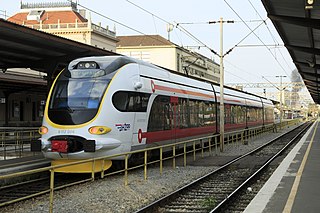
HŽ series 6112 is a class of low-floor electrical multiple units manufactured by the Croatian company Končar - Electric Vehicles, operated by Croatian Railways and the Railways of the Federation of Bosnia and Herzegovina. A total of 55 units are to be manufactured for Croatian Railways by 2024, with the first units being produced in 2011.
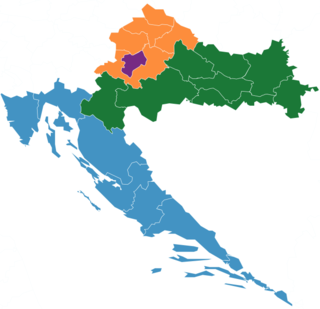
Northern Croatia or North Croatia refers to the northern parts of Croatia, encompassing Zagreb, Varaždin, Međimurje, Zagorje and Koprivnica-Križevci counties, including the cities of Zagreb, Varaždin, Čakovec, Krapina, Koprivnica and Križevci. The region is home to the Kajkavian dialect, which some consider to be a separate language of its own. The region borders Hungary to its north-east and Slovenia to its north-west.

The state border–Botovo–Koprivnica–Dugo Selo railway, officially designated the M201 railway, is a 79.692-kilometre (49.518 mi) railway line in Croatia that connects the Croatian city of Dugo Selo, situated east of national capital Zagreb, with the Hungarian rail network. It is part of the Pan-European Corridor V, branch b, which runs from Rijeka to Budapest. The line is fully electrified and mostly single-tracked. It is used for freight and passenger traffic.
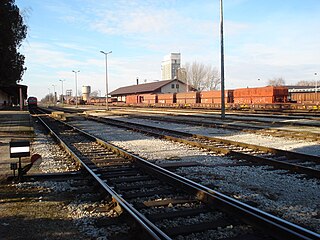
The Zaprešić–Čakovec railway, officially designated as the R201 railway, is a 100.6-kilometre (62.5 mi) railway line in northwest Croatia that connects the towns of Zaprešić and Čakovec, opened in 1886 in former Kingdom of Croatia-Slavonia. It is partially electrified single-tracked railway. The section between Zaprešić and Zabok is also a branch part of Pan-European Corridor X. Most of the corridor passes through Hrvatsko Zagorje region, connecting the largest part of Međimurje and Hrvatsko Zagorje with Zagreb, spanning through four counties. The line separates at the Zaprešić station from the M101 railway. The line is used for passenger (regional) and freight traffic.

The Zagreb Glavni kolodvor–Dugo Selo railway, officially designated the M102 railway, is a 22.202-kilometre (13.796 mi) railway line in Croatia that connects the Croatian capital city Zagreb with the Dugo Selo. It is part of the Pan-European Corridor V, branch b, which runs from Rijeka to Budapest and the Pan-European Corridor X. The line is fully electrified and double-tracked. The M102 railway connects to several other railway lines within the Zagreb railway node linking the capital to other parts of Croatia and neighbouring countries. Besides Zagreb Glavni kolodvor and Dugo Selo, the west and east termini of the railway, the line serves six other railway stations. One of them is Zagreb Borongaj, where the L203 railway connects as a branch line. The line is used for passenger and freight traffic.
The Dugo Selo–Novska railway, officially designated as the M103 railway, is a 83.405-kilometre (51.825 mi) railway line in Croatia that connects Dugo Selo, situated east of national capital Zagreb, to Novska and the M105 railway extending east towards Belgrade. Its route follows the Sava River valley. It is an integral part of railway Pan-European Corridor X running from Salzburg and Ljubljana towards Skopje and Thessaloniki.

The state border–Savski Marof–Zagreb Glavni kolodvor railway, officially designated as the M101 railway, is a 26.709-kilometre (16.596 mi) railway line in Croatia, connecting the nation's capital Zagreb and its main railway station to the Slovene railway network west of Savski Marof and further on with Ljubljana. Its route follows the Sava Valley. It is an integral part of the Pan-European Corridor X running from Salzburg and Ljubljana towards Skopje and Thessaloniki. The line is electrified and double-tracked. The line is used for passenger and freight traffic.
The Zagreb Glavni kolodvor–Sisak–Novska railway, officially designated the M502 railway is a 116.8-kilometre (72.6 mi) railway line in Croatia connecting Zagreb to Sisak and Novska. Until 2014, the railway was classified as M104.

The Zabok – Krapina – Đurmanec – state border with Slovenia railway, officially designated as the R106 railway, is a 27.19 km (16.8 mi) long railway line in north-west Croatia which originates out of the regional corridor R201 in Zabok and connects with Slovenian railway network near Rogatec.
